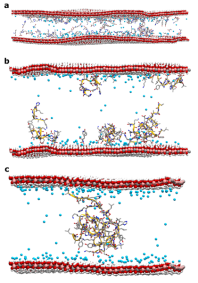
Our research focus is on the use and development of molecular models and computational techniques for the study of processes involving natural materials, minerals and interactions at their interfaces.
We have unique multidisciplinary background, bringing together knowledge from theoretical and experimental chemistry, material and environmental sciences, geosciences and astrobiology. We aspire for our work to foster a step-change in computational modelling, ensuring that the work we do is of direct benefit to our society.
The applications of our research are vast from the origins of life, biosignature identification, soil and water pollution remediation, nuclear waste storage, enhanced oil recovery and fuel additives, all supported through ongoing software development.
MAterials of interest
Our passion is in studying how the finest changes naturally occurring in natural materials affect their properties and interactions with other species in the environment. To this end, we must ensure that the material models used in the simulation are truthfully representative of their experimental counterparts.
BIOCHAR MATERIALS

Biochar is a remarkable material! Made from pyrolysis of biomass (byproduct of anthropogenic waste) they have been used for soil amendment, carbon deposition and, more recently, for sequestration of pollutants. With a poorly defined overall structure, semi-amorphous, comprised of a variety of chemical structures and functional groups, means that creating a representative molecular model of biochar is not a simple task. Our group has been working on developing these models, with the goal of ensuring they are available for the biochar research community. Recently, we have shared an approach to creating representative structures of biochars based on experimentally determined descriptors. We then extended this approach to integrate the control of microporosity, a key factor influencing biochar performance, into the models.
CLAY & Layered MINERALS
For many years we have been working with clay minerals. While they are comprised of silicate layers, the smallest substitutions in the structure result in dramatic changes to its properties, so studying these minerals is very rewarding!
Yet, many models of clay minerals seen in published works (including our earlier ones) do not incorporate these finest structural variations and, therefore, are unable to represent their structures and properties truthfully. To facilitate the construction of clay models and aid in their high-throughput simulations and analysis, we have created ClayCode software.
Thanks to ClayCode, we were able to study how the effects of even the smallest changes in clay structures impact the retention and preservation of protobiomolecules, or mobility of natural organic molecules in soils.
ICES
While hexagonal ice is common on Earth, this is not the same across the universe. To this end, molecular modelling (coupling classical MD and QM) can aid in understanding the interactions in the interstellar medium or icy moons and planets.
Applications
Origins of Life

The origins of life have been the subject of much research, but fundamental questions still remain unanswered. We have a long interest in investigating the surface-supported abiogenetic formation of proto-biomolecules in early Earth and extraterrestrial conditions, as well as the preservation of potential biosignatures.
A lecture titled Computational Chemistry – Space & Time Travellers Tool delivered at the Virtual Winter School on Computational Chemistry on the 29th of January 2025. Please cite as DOI:10.5281/zenodo.14938180.
Pollution Remediation
The rise of densely populated environments brings new challenges to our society. One of many is the management and disposal of increasingly diverse pollutants. Our work aims to identify the key properties making naturally occurring materials capable of adsorbing small organic pollutants.
Biochars produced at low (450C) and high (800C) temperatures show a noticeable difference in Mn2+ uptake from solution.
Shale Oil characteristics

Enhanced oil recovery has become commonplace in order to maximise oil field production. Through our work we aim to elucidate the mechanisms behind this process and to understand the interactions within the shales.
Unraveling Slow Motions in Crystalline Materials
The applicability of molecular dynamics is limited by accessible timescales, often leading to simulations that only describe static states and omit information on the transition rates and pathways. My work focuses on the development of methods to describe slow dynamics in solids, coupling the information to the solid-state NMR observables.
Production of High surface materials

Layered materials, such as graphene, clays, layered double hydroxides, can be found in a wealth of technological applications. Often, the performance of these materials depends on the accessibility of their large surfaces. The increase of the surface area is often obtained via post-production treatment with a range of organic solvents. The hunt for a perfect solvent is the focus of thousands of hours in the laboratories. Working with experimental and industrial collaborators, we use our computational pipelines to rationalise the key interactions behind specific delimitations, helping to find that perfect solvent for the material in mind.
Crystallisation in Fuels
Wax formation in petroleum impacts the ease of its transportation and use. There are numerous wax crystal inhibitors on the market, but their mode of action is still poorly understood. Multi-scale computer simulations allow elucidating mechanisms of wax formation and inhibition, guiding further development of cold flow additives.
Mixing and Separation in PolymerIC matriCes
Many of our daily products rely on polymeric systems. For instance, the shelf life of products containing adhesives is determined by the rates of their component mixing and separation. These often are slow processes not tractable by atomistic or even coarse-grained molecular dynamics, requiring the usage of enhanced sampling techniques and additional methods. While a lot of the work we have done is embargoes, to facilitate the set-up of complex polymeric systems we have developed software Assemble!
